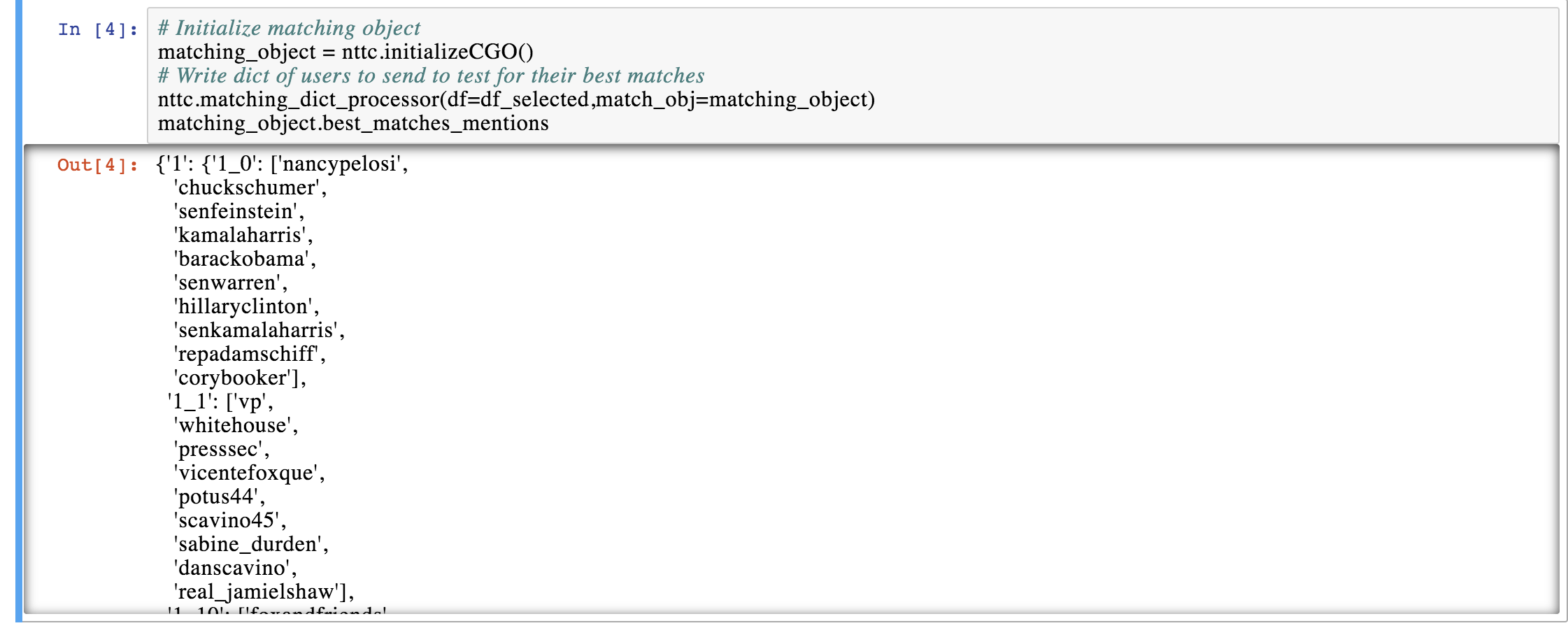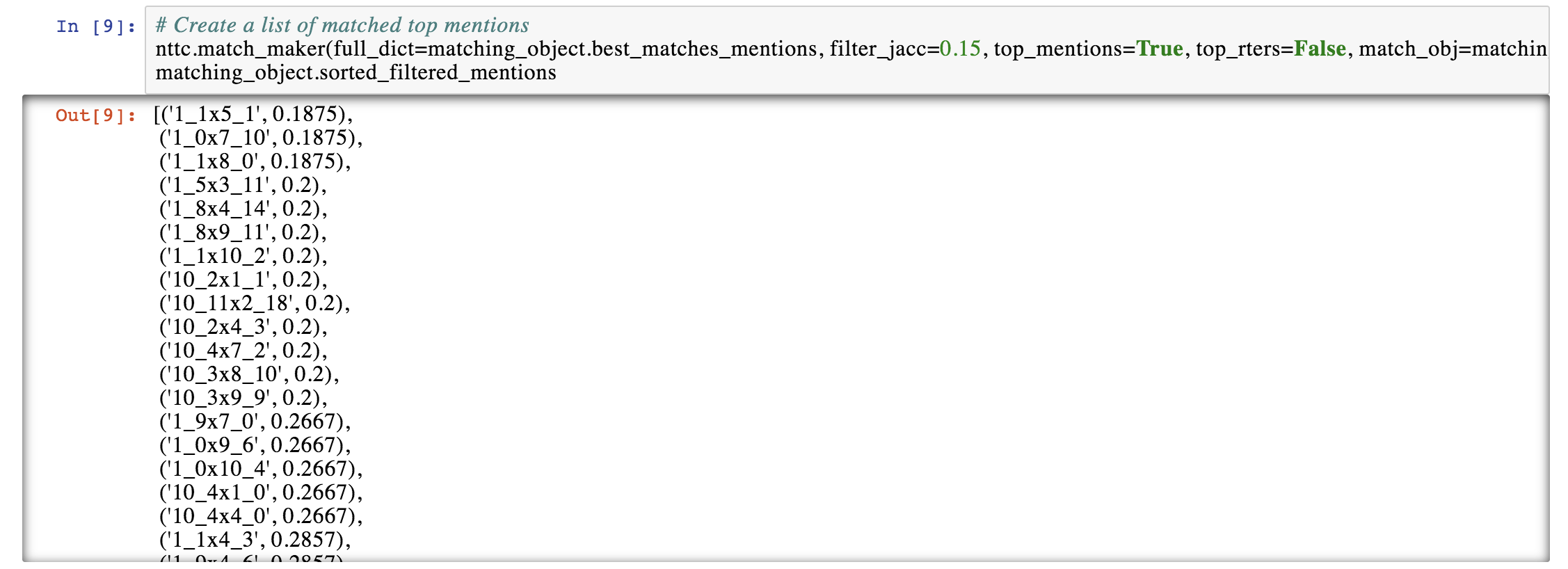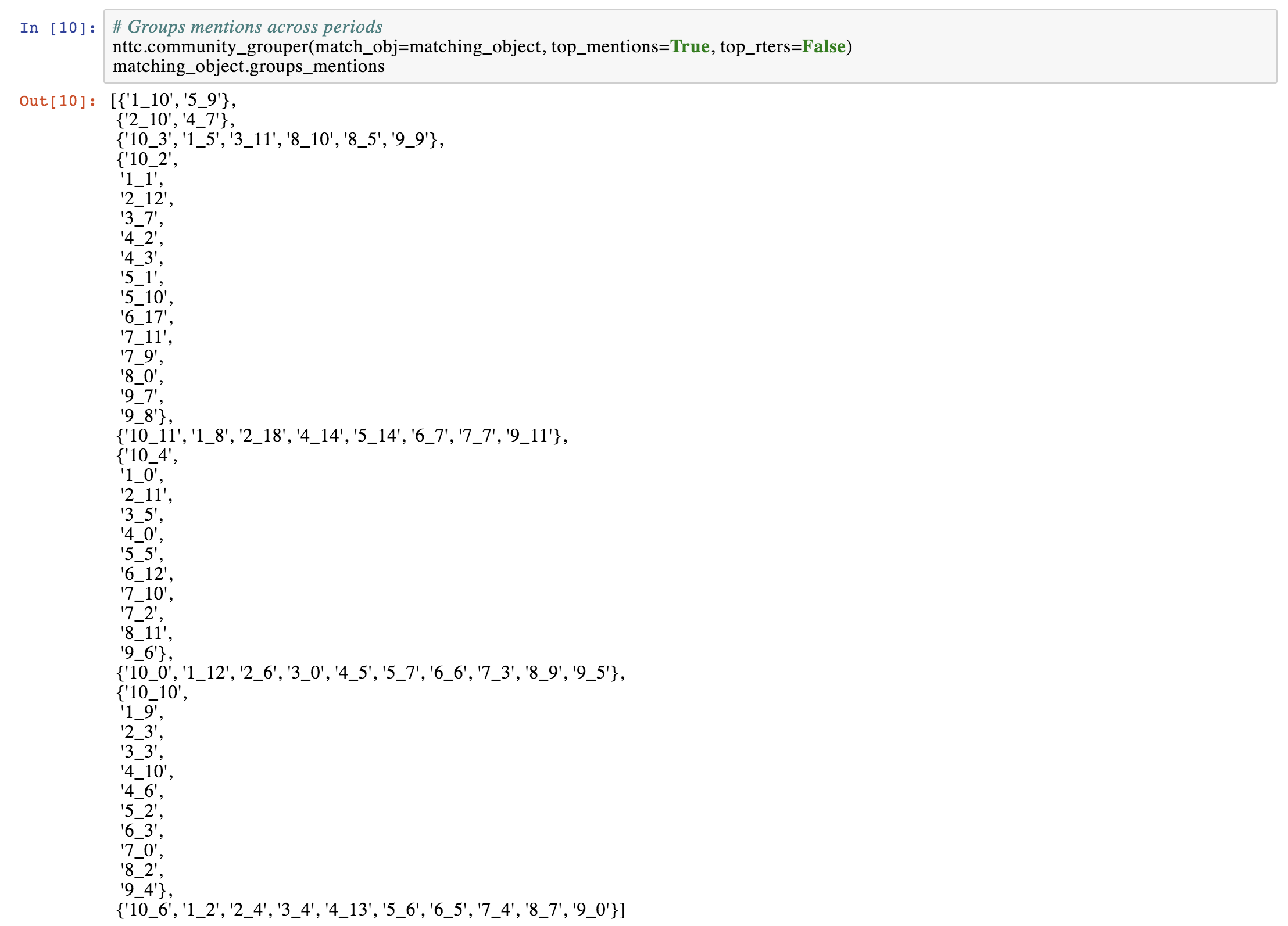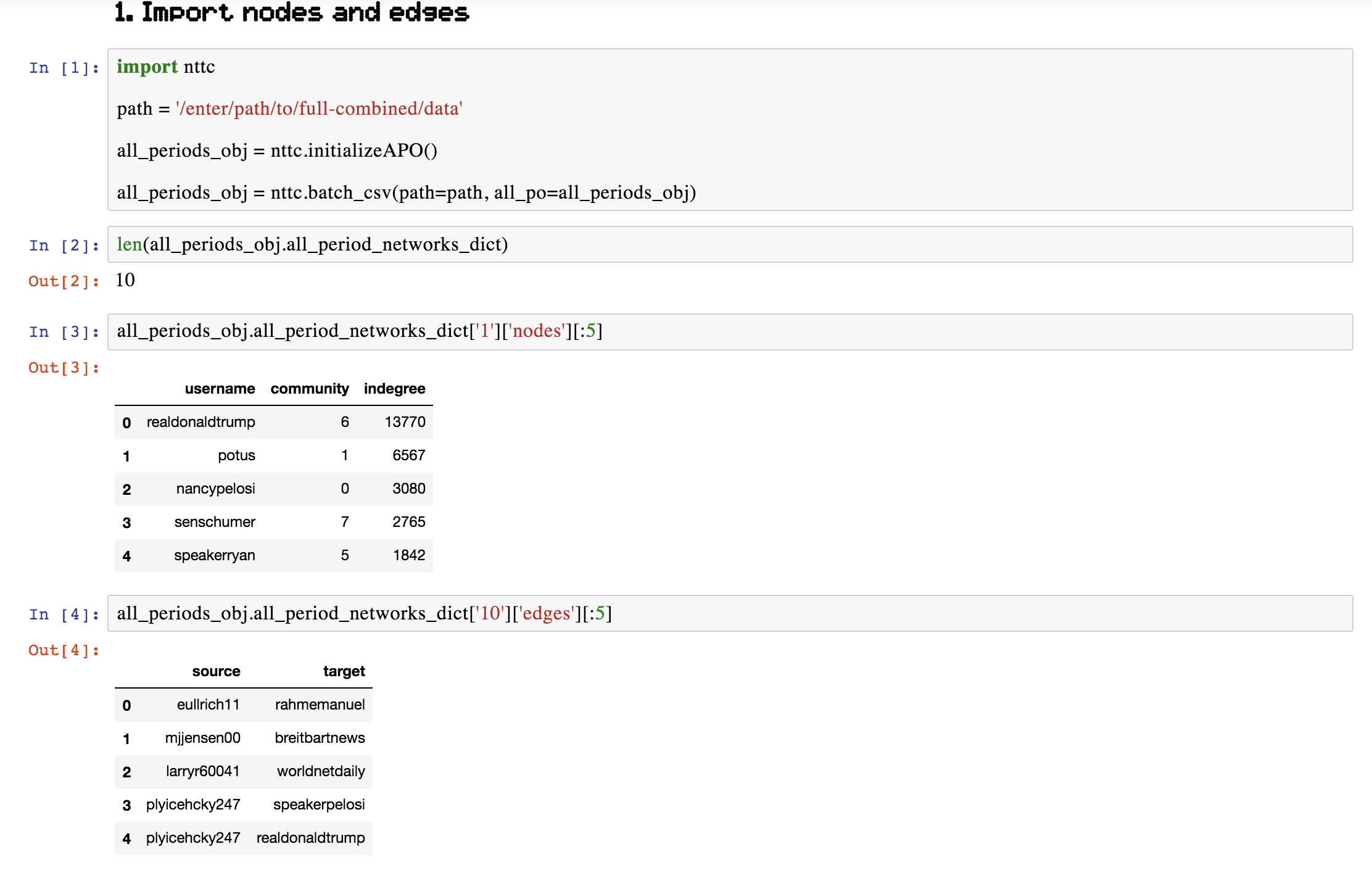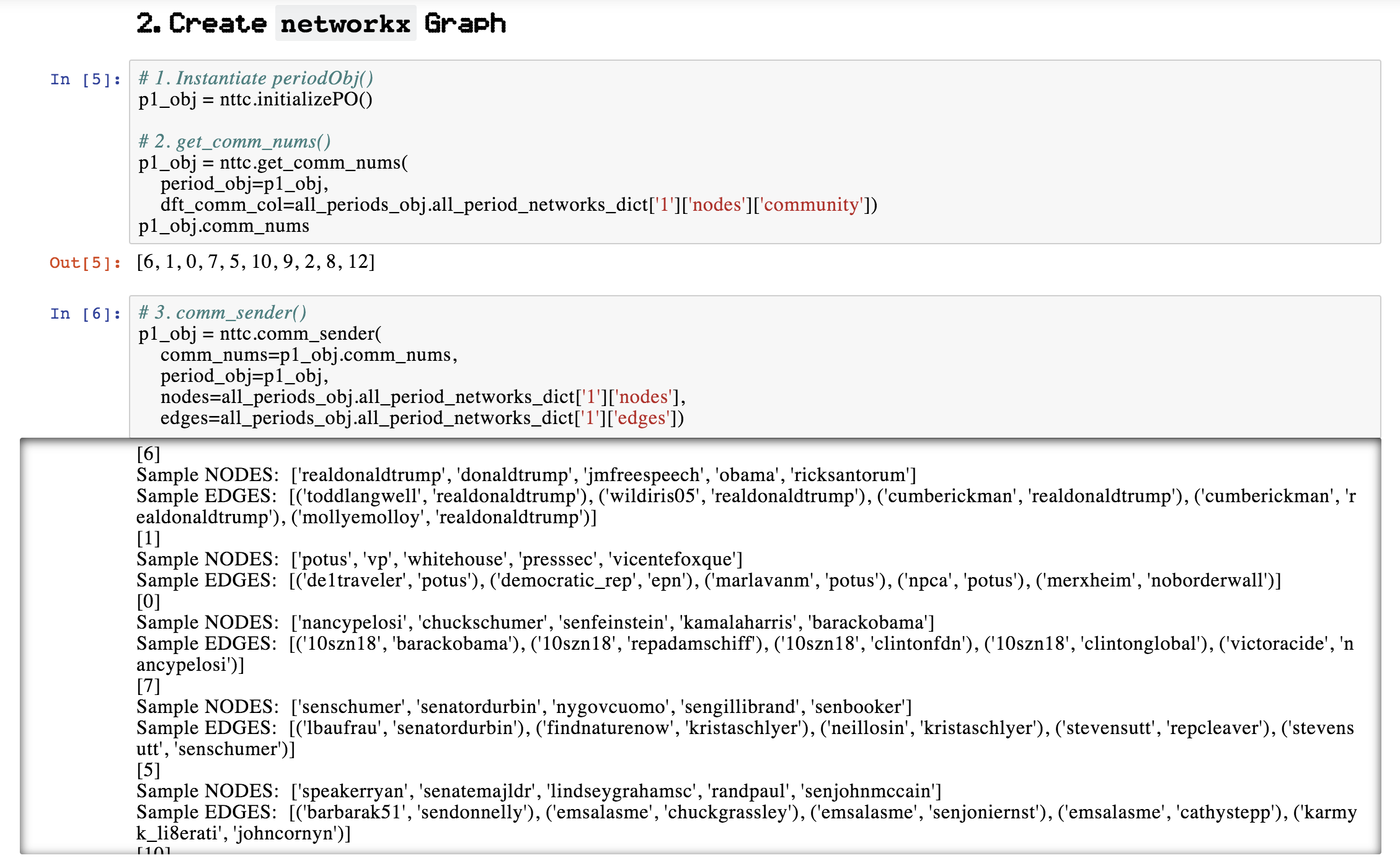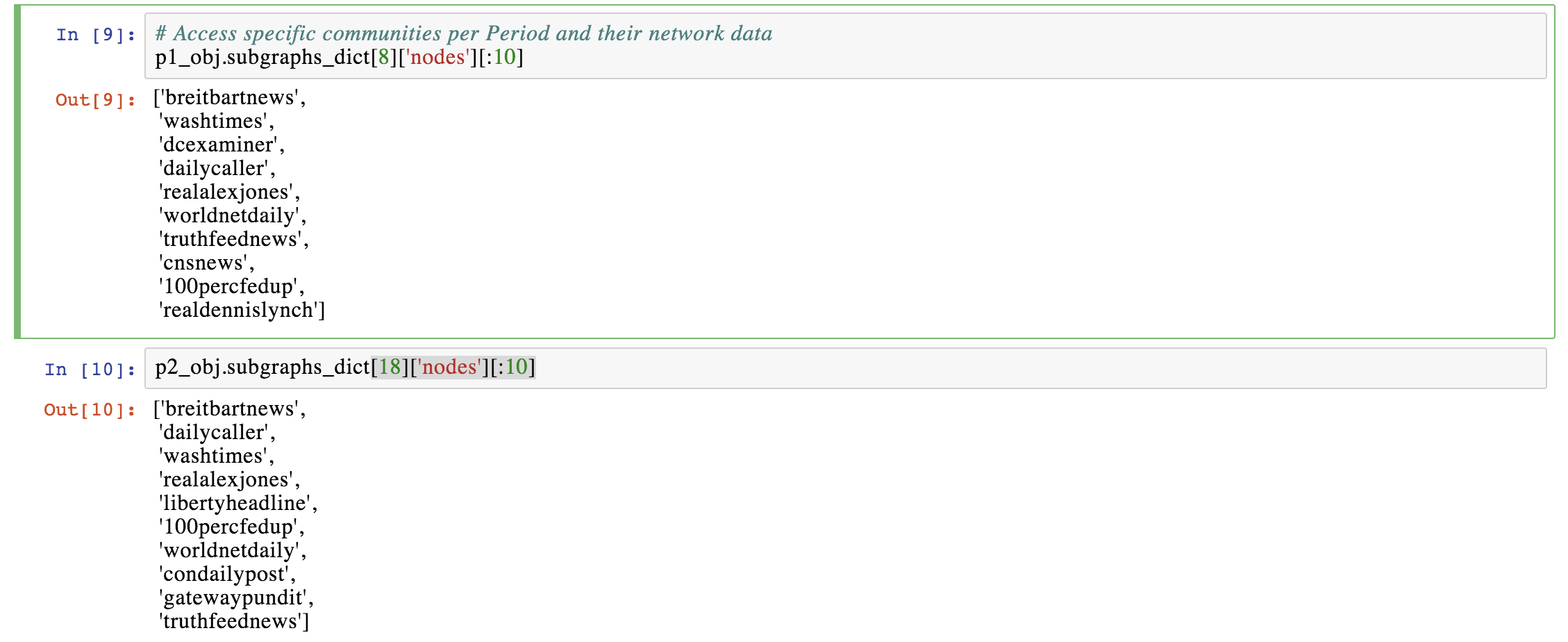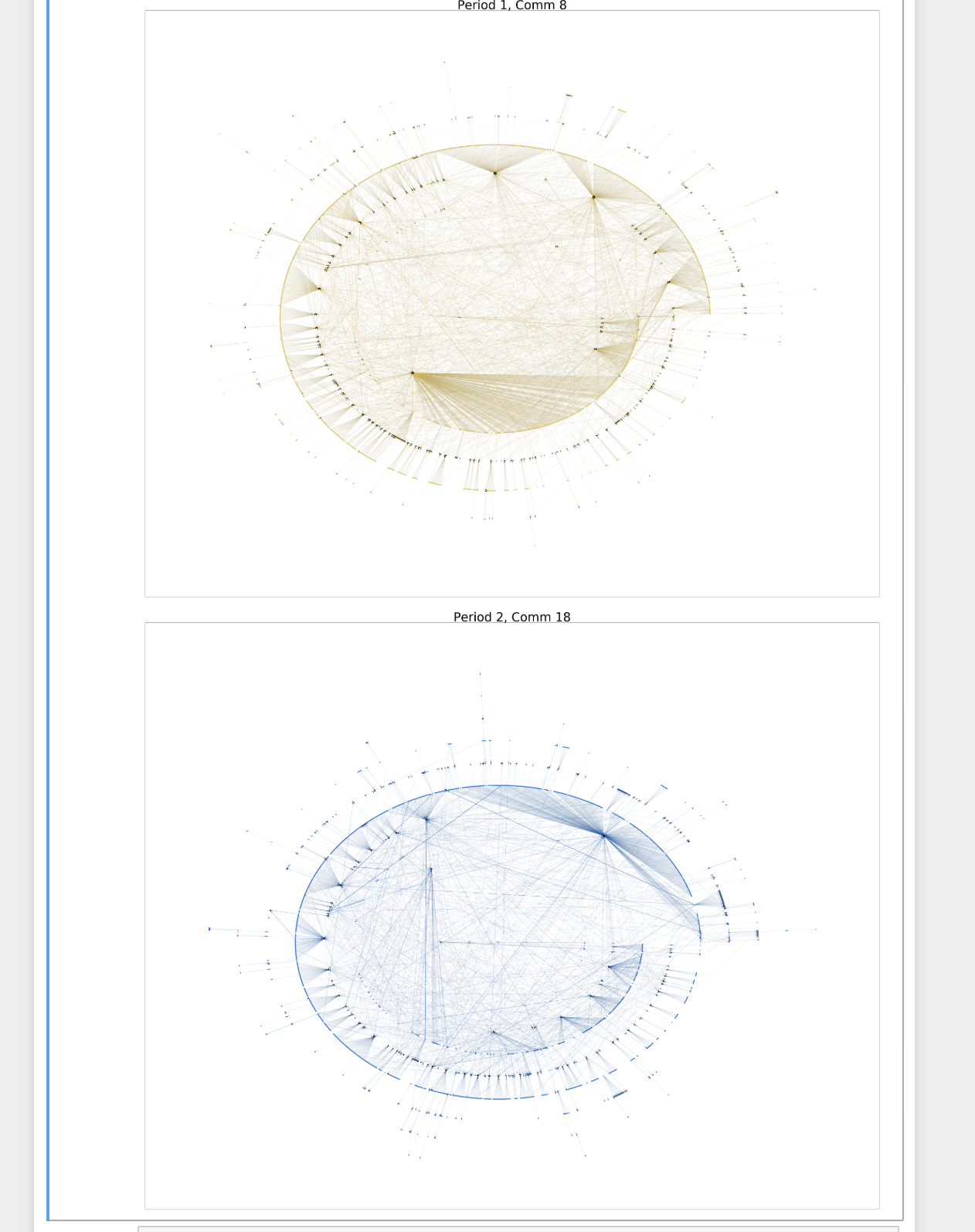A set of functions that process and create topic models from a sample of community-detected Twitter networks' tweets. It also analyzes if there are potential persistent community hubs (either/and by top mentioned or top RTers), and can process and visualize network data across periods and communities.
Project description
NTTC (Name That Twitter Community!): Process and analyze community-detected data
by Chris Lindgren chris.a.lindgren@gmail.com Distributed under the BSD 3-clause license. See LICENSE.txt or http://opensource.org/licenses/BSD-3-Clause for details.
Overview
A set of functions that process and create topic models from a sample of community-detected Twitter networks' tweets. It also analyzes if there are potential persistent community hubs (either/and by top mentioned or top RTers).
It assumes you seek an answer to the following questions:
- What communities persist or are ephemeral across periods in the corpora, and when?
- What can these communities be named, based on their top RTs and users, top mentioned users, as well as generated topic models?
- Of these communities, what are their topics over time?
- TODO: Build corpus of tweets per community groups across periods and then build LDA models for each set.
Accordingly, it assumes you have a desire to investigate communities across periods and the tweets from each detected community across already defined periodic episodes with the goal of naming each community AND examining their respective topics over time in the corpus.
It functions only with Python 3.x and is not backwards-compatible (although one could probably branch off a 2.x port with minimal effort).
Warning: nttc performs no custom error-handling, so make sure your inputs are formatted properly! If you have questions, please let me know via email.
System requirements
Installation
pip install nttc
Objects
nttc initializes and uses the following objects:
-
periodObject: Object with properties that store per Community subgraph properties. Object properties as follows:.comm_nums: List of retrieved community numbers from the imported nodes data.subgraphs_dict: Dictionary of period's community nodes and edges data.
-
communitiesObject: Object with properties that generate topic model and also help you name them more easily. Object properties are as follows:.content_slice: dict of a sample community's content segments.split_docs: split version of sampled tweets.id2word: dict version of split_docs.texts: Listified version of sample.corpus: List of sample terms with frequency counts.readme: If desired, printout readable version.model: Stores the LDA topic model object.perplexity: Computed perplexity score of topic model.coherence: Computed coherence score of topic model.top_rts: Sample of top 10 Rters and RTs for the community.top_mentions: Sample of top 10 people mentioned.full_hub: Combined version of top_rts and top_mentions as a DataFrame
-
communityGroupsObject: Object with properties that analyze community likeness scores and then groups alike communities across periods. Object properties as follows:.best_matches_mentions: Dictionary of per Period with per Period hub top_mentions (users) values as lists.best_matches_rters: Dictionary of per Period with per Period hub top_rters (users) values as lists.sorted_filtered_comms: List of tuples, where each tuple has 1) the tested pair of communities between 2 periods, and 2) their JACC score. Example:('1_0x4_0', 0.4286).groups_mentions: A list of sets, where each set are alike mention groups across periods, based on your given JACC threshold:[{'1_8', '2_18'}, {'3_7', '4_2'}, {'7_11', '8_0'}, {'10_11', '4_14', '5_14', '6_7', '9_11'}, {'1_0', '2_11', '3_5', '4_0', '5_5', '6_12'}, {'10_10', '1_9', '2_3', '3_3', '4_6', '5_2', '6_3', '7_0', '8_2', '9_4'}, {'10_6', '1_2', '2_4', '3_4', '4_13', '5_6', '6_5', '7_4', '8_7', '9_0'}, {'10_0', '1_12', '2_6', '3_0', '4_5', '5_7', '6_6', '7_3', '8_9', '9_5'}].groups_rters: A list of sets, where each set are alike RTer groups across periods, based on your given JACC threshold:[{'1_8', '2_18', '5_14'}, {'10_20', '5_18'}, {'5_2', '6_3', '7_0'}, {'5_1', '7_1'}, {'10_12', '2_3', '3_13', '6_8', '7_5', '8_4', '9_1'}]
General Functions
nttc contains the following general functions:
initializePO: Initializes a periodObject().initializeCGO: Initializes a communityGroupsObject().get_csv: Loads CSV data as a pandas DataFrame.batch_csv: Merge a folder of CSV files into either one allPeriodsObject that stores a dict of all network nodes and edges per Period, or returns only the aforementioned dict, if no object is passed as an arg.write_csv: Writes DataFrame as a CSV file.
Infomap Data-Processing Functions
nttc contains the following functions to process data into a usable format for the Infomap network analysis system.
For example, it takes an edge list with usernames (username1, username2), and it translates it into the necessary Pajek file format (.net).
listify_unique_users: Take edge list and create a list of unique userscheck_protected_dataype_names: Verify that edge names don't conflict with Python protected datatypes. If they do, append 2 underscores to its end and log it.index_unique_users: Take list of unique users and append IDstarget_part_lookup: Lookup target in unique list and return to netify_edges()write_net_dict: Writes s Dict of vertices (nodes) and arcs (edges) in preperation for formatting it into the Pajek file format (.net). It returns a dictionary akin to the following:p_dict = { 'vertices': verts, # A List of vertices (nodes) with an ID [1, user1] 'arcs': arcs # A list of arcs (edges) [source, target] }vert_lookup: Helper function forwrite_net_dict. It finds the matching username and returns the period_based ID.netify_edges: Accepts list of lists (edges) and replaces the usernames with their unique IDs. This prepares output for the infomap code system.write_net_txt: Outputs .txt file with edges in a .net format for the Infomap system:source target [optional weight] 1 2 2 4 2 8 5 4 ...
It also contains functions that enable you to isolate and output a CSV file with the hubs from each period. It does so with custom parsers for the infomap .map and .ftree file formats:
read_map_or_ftree: Helper function for infomap_hub_maker. Slices period's.mapor.ftreeinto their line-by-line indices and returns a dict of those values for use.indices_getter: Helper function for batch_map. Parses each line in the file and returns a list of lists, where each sublists is a line in the file.- Future version could accept a dict of regex delimiters and parse file base on those given parameters.
batch_map: Retrieves all map files in a single directory. It assumes that you have only the desired files in said directory. Returns a dict of each files based on their naming scheme with custom regex pattern. Each key denotes the file and its values are list of lists, where each sublist is a lines in the file.regex= Regular expression for filename schemepath= String. Path for directory with .map or .ftree files
ranker: Appends rank and percentages at different aggregate levels.- Args:
rank_type= String. Argument option for type of ranking to conduct. Currently only per_hub.tdhn= Dict of corpus. Traverses the 'info_hub'
- Return
tdhn= Updated 'info_hub' with 'percentage_total' per hub and 'spot' for each node per hub,
- TODO: Add per_party and per_hubname
- Args:
append_rank: Helper function for ranker(). It appends the rank number for the 'spot' value.append_percentages: Helper function for ranker(). Appends each node's total_percentage to the list- Args:
rl= List of lists. Ranked list of nodes per hub
- Args:
score_summer(): Tally scores from each module per period and append a score_total to each node instance per module for every period.- Args:
dhn= Dict of hubs returned from info_hub_maker
- Args:
get_period_flow_total: Helper function for score_summer. Tallies scores per Period across hubs.- Args:
lpt= List. Contains hub totals per Period.
- Return
- Float. Total flow score for a Period.
- Args:
get_score_total: Helper function for score_summer. Tallies scores per Hub.- Args:
list_nodes= List of Dicts
- Return
total= Float. Total flow score for a Hub.
- Args:
infomap_hub_maker: Takes fully hydrated Dict of themaporftreefiles and parses its Nodes into per Period and Module Dicts.- Args:
file_type= String. 'map' or 'ftree' file type designationdict_map= Dict of map filesmod_sample_size= Integer. Number of modules to samplehub_sample_size= Integer. number of nodes to sample for "hub" of each module
- Output:
dict_map= Dict with newinfo_hubkey hydrated with hubs
- Args:
output_infomap_hub: Takes fully hydrated infomap dict and outputs it as a CSV file.- Args:
header= column names for DataFrame and CSV;- Assumes they're in order with period and hub in first and second position
dict_hub= Hydrated Dict of hubspath= Output pathfile= Output file name
- Args:
sampling_module_hubs: Compares hub set with tweet data to ultimately output sampled tweets with hub information.- Args:
period_dates: Dict of lists that include dates for each period of the corpusperiod_check: String for option: Check against 'single' or 'multiple'period_num: Integer. If period_check == 'single', provide integer of period number.df_all_tweets: Pandas DataFrame of tweetsdf_hubs: Pandas DataFrame of infomapped hubstop_rts_sample: Integer of desired sample size of sorted top tweets (descending order)hub_sample: Integer of desired sample size to outputcolumns: List of column names; each as a String. **Must match column names from tweet and hub data sets
- Returns DataFrame of top sampled tweets
- Args:
add_infomap: Helper function forsampling_module_hubs. It cross-references the sampled .- Args:
- dft: DataFrame of sampled tweet data
- dfh: Full DataFrame of hubs data
- period_num: Integer of particular period number
- Returns List of Dicts with hub and info_name mentions info
- Args:
batch_output_period_hub_samples: Periodic batch output that saves sampled tweets as a CSV. Assumes successively numbered periods.- Args:
- module_output: DataFrame of tweet sample data per Period per Module
- period_total: Interger of total number of periods
- file_ext: String of desired filename extension pattern
- period_path: String of desired path to save the files
- Returns nothing
- Args:
Create samples of tweets based on the hubs from each detected community:
- Create infomap hubs from
.ftreefiles:
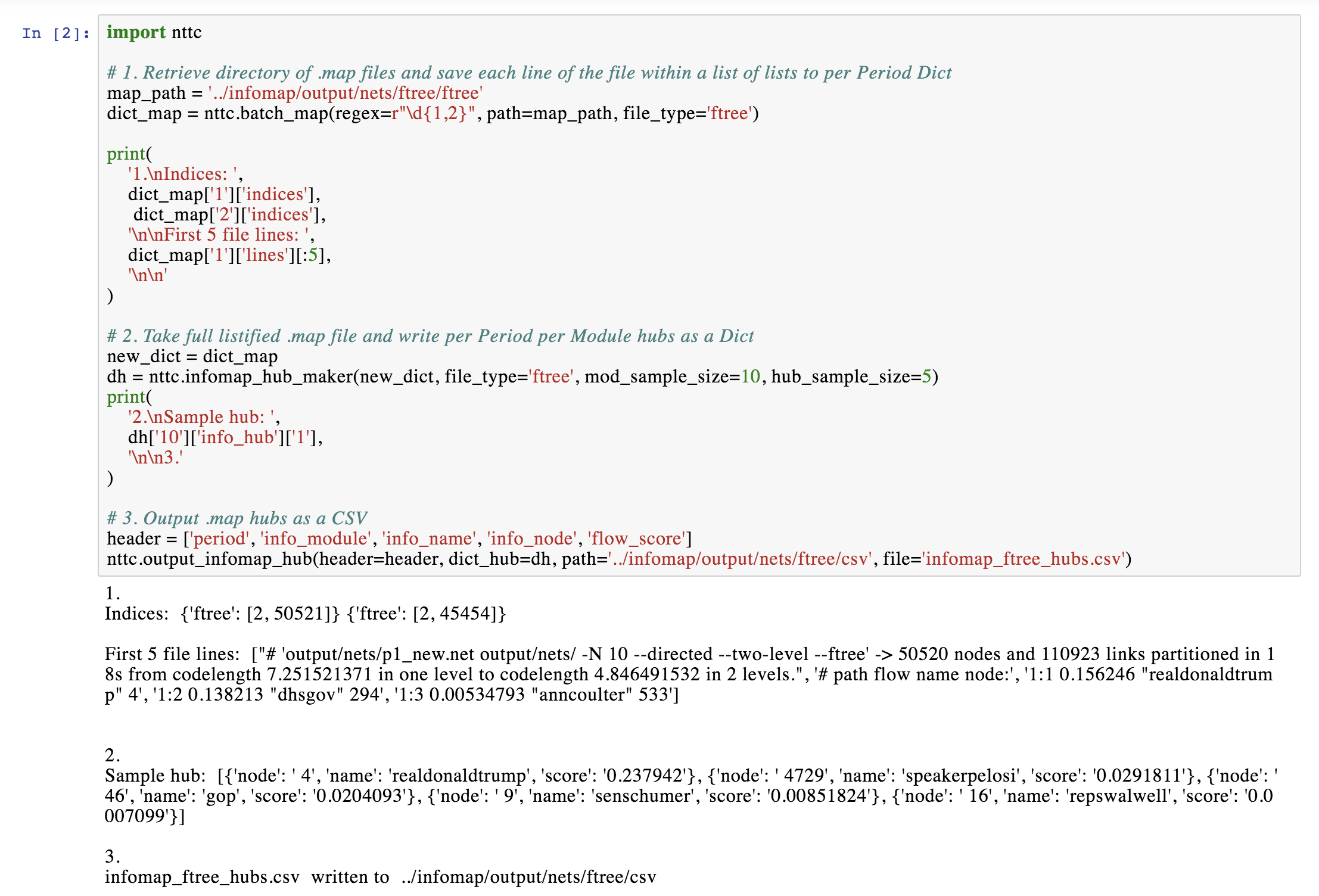 2. Create a sample of tweet data cross-referenced with the infomapped hub file:
2. Create a sample of tweet data cross-referenced with the infomapped hub file:
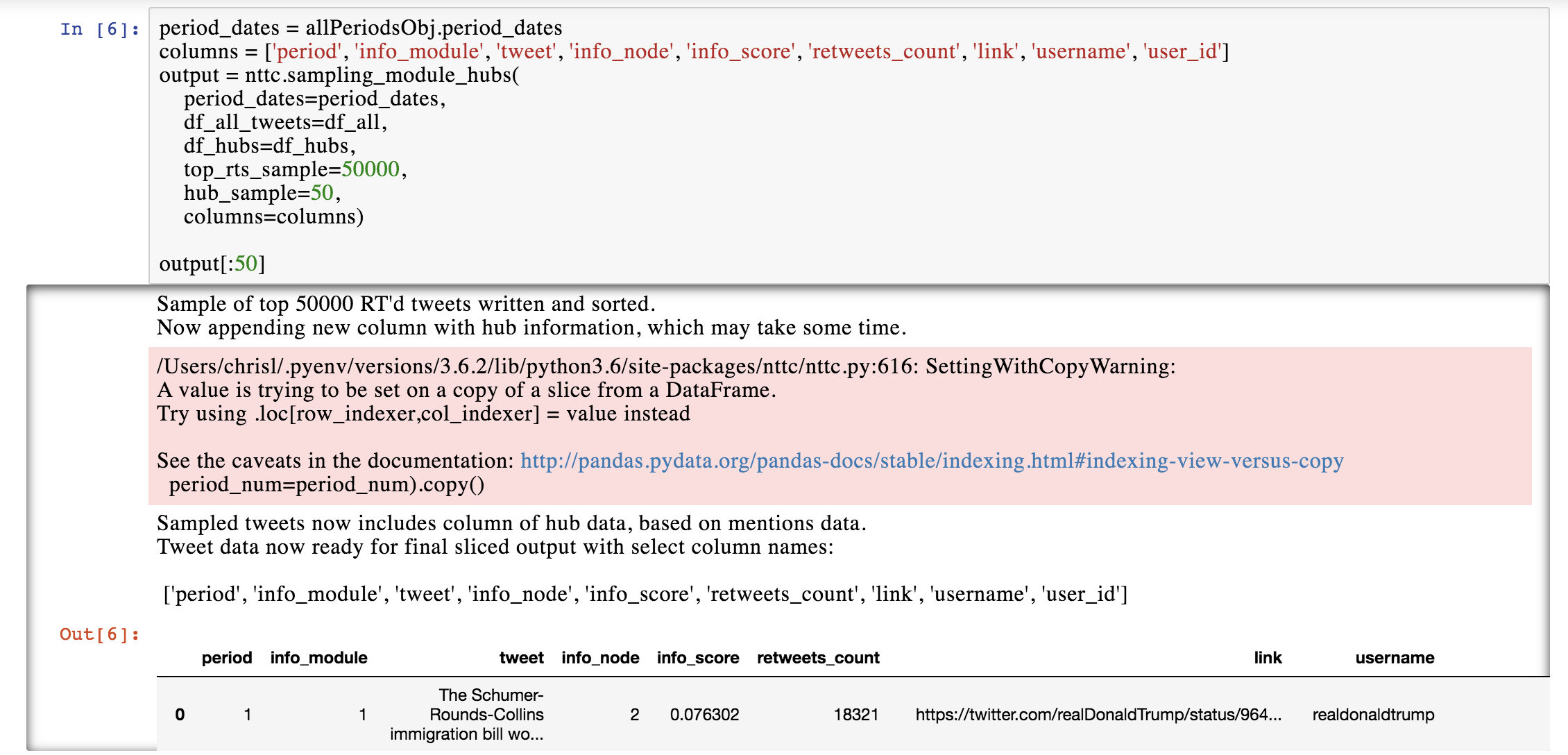 3. Output sample in a batch based on the number of periods:
3. Output sample in a batch based on the number of periods:

Create a sample of hubs ranked by their information flow scores:
import nttc
# 1. Retrieve directory of .map files and save each line of the file within a list of lists to per Period Dict
map_path = '../infomap/output/nets/maps'
dict_map = nttc.batch_map(regex=r"\d{1,2}", path=map_path, file_type='map')
print(
'1.\nIndices: ',
dict_map['1']['indices'],
dict_map['2']['indices'],
'\n\nFirst 5 file lines: ',
dict_map['1']['lines'][:5],
'\n\n'
)
# 2. Take full listified .map file and write per Period per Module hubs as a Dict
new_dict = dict_map
dh = nttc.infomap_hub_maker(new_dict, file_type='map', mod_sample_size=10, hub_sample_size=-1)
print(
'2.\nSample hub: ',
dh['10']['info_hub']['1'][:10]
)
# 3. Updated hubs with scores
dhn = dh
totals_dhn = nttc.score_summer(dhn, hub_sample_size=5)
print(
'\n3. Updated hubs with scores: ',
totals_dhn['1']['info_hub']['1'][:20]
)
# 4. Ranked hubs with percentages
tdhn = totals_dhn
ranked_tdhn = nttc.ranker(tdhn, rank_type='per_hub')
print(
'\n4. Ranked hubs with percentages:\n\n',
ranked_tdhn['1']['info_hub']['1'][:20]
)
# 5. Output .map hubs as a CSV
header = ['period', 'info_module', 'node', 'name', 'score','total_hub_flow_score','total_period_flow_score','percentage_total','spot','top_name']
nttc.output_infomap_hub(
header=header,
filtered_header_length=4,
dict_hub=rtdhn,
path='../infomap/output/nets/maps/csv',
file='infomap_hubs_100_5.csv')
Output:
1.
Indices: {'modules': [7, 5388], 'nodes': [5390, 55909], 'links': [55911, 86141]} {'modules': [7, 5100], 'nodes': [5102, 50554], 'links': [50556, 73404]}
First 5 file lines: ['# modules: 5382', '# modulelinks: 30231', '# nodes: 50520', '# links: 110923', '# codelength: 11.5932']
2.
Sample hub: [{'node': '1', 'name': 'realdonaldtrump', 'score': 0.135007}, {'node': '2', 'name': 'speakerpelosi', 'score': 0.012912}, {'node': '3', 'name': 'gop', 'score': 0.008224}, {'node': '4', 'name': 'senschumer', 'score': 0.002308}, {'node': '5', 'name': 'themarkpantano', 'score': 1.8e-05}, {'node': '6', 'name': 'joelpollak', 'score': 1.8e-05}, {'node': '7', 'name': 'repkevinbrady', 'score': 1.6e-05}, {'node': '8', 'name': 'bike_at_w4', 'score': 1.3e-05}, {'node': '9', 'name': 'busyelves', 'score': 1.3e-05}, {'node': '10', 'name': 'jorgeramosnews', 'score': 1.3e-05}]
3. Updated hubs with scores: [{'node': '1', 'name': 'realdonaldtrump', 'score': 0.088483, 'total_hub_flow_score': 0.24477100000007698, 'total_period_flow_score': 0.45748200000006645}, {'node': '2', 'name': 'dhsgov', 'score': 0.076302, 'total_hub_flow_score': 0.24477100000007698, 'total_period_flow_score': 0.45748200000006645}, {'node': '3', 'name': 'anncoulter', 'score': 0.002534, 'total_hub_flow_score': 0.24477100000007698, 'total_period_flow_score': 0.45748200000006645}, {'node': '4', 'name': 'patriotlexi', 'score': 4.2e-05, 'total_hub_flow_score': 0.24477100000007698, 'total_period_flow_score': 0.45748200000006645}, {'node': '5', 'name': 'realdrolmo', 'score': 1.5e-05, 'total_hub_flow_score': 0.24477100000007698, 'total_period_flow_score': 0.45748200000006645}, {'node': '6', 'name': 'sickoftheswamp', 'score': 1.5e-05}, {'node': '7', 'name': 'rippdemup', 'score': 1.5e-05}, {'node': '8', 'name': 'flying4jc', 'score': 1.5e-05}, {'node': '9', 'name': 'theresamechele', 'score': 1.5e-05}, {'node': '10', 'name': 'chadpergram', 'score': 1.5e-05}, {'node': '11', 'name': 'medicalellen', 'score': 1.5e-05}, {'node': '12', 'name': 'shelley2021', 'score': 1.4e-05}, {'node': '13', 'name': 'lisamei62', 'score': 1.4e-05}, {'node': '14', 'name': 'angeloraygomez', 'score': 1.4e-05}, {'node': '15', 'name': 'john_kissmybot', 'score': 1.4e-05}, {'node': '16', 'name': '1gigisims', 'score': 1.4e-05}, {'node': '17', 'name': 'betzi1l', 'score': 1.4e-05}, {'node': '18', 'name': 'safety_canada', 'score': 1.4e-05}, {'node': '19', 'name': 'jennyjlfortn632', 'score': 1.4e-05}, {'node': '20', 'name': 'michaelbeatty3', 'score': 1.4e-05}]
4. Ranked hubs with percentages:
[{'node': '1', 'name': 'realdonaldtrump', 'score': 0.088483, 'total_hub_flow_score': 0.24477100000007698, 'total_period_flow_score': 0.45748200000006645, 'percentage_total': 1.0, 'spot': 1}, {'node': '2', 'name': 'dhsgov', 'score': 0.076302, 'total_hub_flow_score': 0.24477100000007698, 'total_period_flow_score': 0.45748200000006645, 'percentage_total': 0.3117281050451238, 'spot': 2}, {'node': '3', 'name': 'anncoulter', 'score': 0.002534, 'total_hub_flow_score': 0.24477100000007698, 'total_period_flow_score': 0.45748200000006645, 'percentage_total': 0.010352533592623309, 'spot': 3}, {'node': '4', 'name': 'patriotlexi', 'score': 4.2e-05, 'total_hub_flow_score': 0.24477100000007698, 'total_period_flow_score': 0.45748200000006645, 'percentage_total': 0.000171588954573867, 'spot': 4}, {'node': '5', 'name': 'realdrolmo', 'score': 1.5e-05, 'total_hub_flow_score': 0.24477100000007698, 'total_period_flow_score': 0.45748200000006645, 'percentage_total': 6.12817694906668e-05, 'spot': 5}, {'node': '6', 'name': 'sickoftheswamp', 'score': 1.5e-05}, {'node': '7', 'name': 'rippdemup', 'score': 1.5e-05}, {'node': '8', 'name': 'flying4jc', 'score': 1.5e-05}, {'node': '9', 'name': 'theresamechele', 'score': 1.5e-05}, {'node': '10', 'name': 'chadpergram', 'score': 1.5e-05}, {'node': '11', 'name': 'medicalellen', 'score': 1.5e-05}, {'node': '12', 'name': 'shelley2021', 'score': 1.4e-05}, {'node': '13', 'name': 'lisamei62', 'score': 1.4e-05}, {'node': '14', 'name': 'angeloraygomez', 'score': 1.4e-05}, {'node': '15', 'name': 'john_kissmybot', 'score': 1.4e-05}, {'node': '16', 'name': '1gigisims', 'score': 1.4e-05}, {'node': '17', 'name': 'betzi1l', 'score': 1.4e-05}, {'node': '18', 'name': 'safety_canada', 'score': 1.4e-05}, {'node': '19', 'name': 'jennyjlfortn632', 'score': 1.4e-05}, {'node': '20', 'name': 'michaelbeatty3', 'score': 1.4e-05}]
5. infomap_hubs_100_5.csv written to ../infomap/output/nets/maps/csv
periodObject Functions
get_comm_nums: Filters unique community column values into Listcomm_senderandwrite_community_list: These 2 functions create a dict of nodes and edges to be saved as a property, .subgraphs_dict, of a periodObject. It does so by:- Creates a List of nodes per Community
- Creates a List of edges per Community
- Appends dict of these lists to comprehensive dict for the period.
- Appends this period dict to the period)bject property: .subgraphs_dict
- Returns the object.
add_comm_nodes_edges: Function to more quickly generate new networkX graph of specific comms in a period.add_all_nodes_edges: Function to more quickly generate new networkX graph of all comms in a period.draw_subgraphs: Draws subgraphs with networkX module, but can do so with multiple communities across periods.
communitiesObject Functions
create_hub_csv_files: Writes all of the objects' top rt'd/mentions information as a CSV of "hubs"get_comm_nums: Filters Dataframe column community values into a List.get_all_comms: Slice the full set to community and their respective tweets. Arguments: Full dataframe, strings of column names for community and tweets.comm_dict_writer: Writes per Community tweets into a dictionary.split_community_tweets: Isolates community's tweets, then splits string into list of strings per Tweet preparing them for the topic modeling. Returns as Dataframe of tweets for resepective community.clean_split_docs: Removes punctuation, makes lowercase, removes stopwords, and converts into dataframe for topic modeling.tm_maker: Creates data for TM and builds an LDA TM.get_hubs_top_rts: Appends hubs' top 10 RT'd tweets and usernames to respective period and community object.- Args:
- Dataframe of hub top mentions,
- Dict of Objects with .top_rts,
- String of period number
- Returns: Dict Object with new .top_rts per Object
- Args:
get_hubs_mentions: Appends hubs' mentions data to respective period and community object.- Args:
- Dataframe of hub mentions,
- Dict of Objects,
- String of column name for period,
- String of period number,
- String of column name for the community number
- Returns: Dict Object with new .top_mentions per Object
- Args:
merge_rts_mentions: Merges hubs' sources and mentions data as a full list per Community.
communityGroupsObject Functions
matching_dict_processor: Processes input dataframe of network community hubs for use in the tsm.match_communities() function.- Args: A dataframe with Period, Period_Community (1_0), and top mentioned (highest in-degree) users
- Returns: Dictionary of per Period with per Period_Comm hub values as lists:
{'1': {'1_0': ['nancypelosi', 'chuckschumer', 'senfeinstein', 'kamalaharris', 'barackobama', 'senwarren', 'hillaryclinton', 'senkamalaharris', 'repadamschiff', 'corybooker'], ... }, ... '10': {'10_3': [...] } }
match_maker: Takes period dict from matching_dict_processor() and submits to tsm.match_communities() method. Assigns, filters, and sorts the returned values into- Args: Dictionary of per Period with per Period_Comm hub values as lists; filter_jacc threshold value (float) between 0 and 1.
- Returns: List of tuples: period_communityxperiod_community, JACC score
[('1_0x4_0', 0.4286), ('1_0x2_11', 0.4615), ('1_0x3_5', 0.4615), ... ]
plot_bar_from_counter: Plot the community comparisons as a bar chart.- Args:
- ax=None # Resets the chart
- counter = List of tuples returned from match_maker(),
- path = String of desired path to directory,
- output = String value of desired file name (.png)
- Returns: Nothing.
- Args:
community_grouper(): Controller function for process to group together communities found to be similar across periods in the corpus. It uses the 1) group_reader() and 2) final_grouper() functions to complete this categorization process.- Args: Accepts the network object (net_obj) with the returned value from nttc.match_maker(), which should be saved as .sorted_filtered_comms property: a list of tuples with sorted and filtered community pairs and their score, but it only uses the community values.
- Returns: A list of sets, where each set is a grouped recurrent community: For example, 1_0, where 1 is the period, and 0 is the designated community number.
[{'1_8', '2_18'}, {'3_7', '4_2'}, {'7_11', '8_0'}, {'10_11', '4_14', '5_14', '6_7', '9_11'}, {'1_0', '2_11', '3_5', '4_0', '5_5', '6_12'}, {'10_10', '1_9', '2_3', '3_3', '4_6', '5_2', '6_3', '7_0', '8_2', '9_4'}, {'10_6', '1_2', '2_4', '3_4', '4_13', '5_6', '6_5', '7_4', '8_7', '9_0'}, {'10_0', '1_12', '2_6', '3_0', '4_5', '5_7', '6_6', '7_3', '8_9', '9_5'}]
group_reader(): Takes the period_community pairs and appends to dict if intersections occur. However, the returned dict requires furter analysis and processing, due to unknown order and content from the sorted and filtered communities, which is why they are then sent to the final_grouper by community_grouper, after completion here.- Args: Accepts the initial group dict, which is cross-referenced by the pair of period_community values extracted via a regex expression.
- Returns: A dict of oversaturated comparisons, which are sent to final_grouper() for final analysis, reduction, and completion.
final_grouper(): Takes the period_community dictionaries and tests for their intersections. Then, it takes any intersections and joins them with .union and appends them into a localized running list, which will all be accrued in a running master list of that community. From there, each community result will be sorted by their length in descending order.- Args: Accepts the group dict from group_reader().
- Returns: A dict of all unique period_community elements (2 or more) found to be similar.
Build a topic model per Community and save all variables to respective object properties.
import nttc
data_path = '//Users/name/project/periods/top_rts/encoded'
__file__ = 'p1_comm_top500mentions_in_top10000_rts_count_uid.csv'
dtype_dict={
'community': str,
'tweets': str,
'retweets_count': float,
'link': str,
'username': str,
'user_id': float
}
# 1. Load CSV
df_tweets = nttc.get_csv(data_path, __file__, dtype_dict)
# 2. Get community numbers into a List
comm_list = nttc.get_comm_nums(df_tweets)
# 3. Write dictionary of tweets organized by per Community perspective
dict_all_comms = nttc.comm_dict_writer(comm_list, df_tweets, 'community', 'tweets')
# 4 . Process tweets for each community
split_dict_all_comms = nttc.split_community_tweets(dict_all_comms, 'tweets')
# 5. Build the topic model
tms_full_dict = nttc.tm_maker(random_seed=2018,
split_comms=split_dict_all_comms,
num_topics=5,
random_state=100,
update_every=1,
chunksize=100,
passes=10,
alpha='auto',
per_word_topics=True) #pass any of the following gensim LDATopicModel() object arguments here
Sample Output from Above Code
3 Perplexity: -7.618915328673395
3 Coherence Score: 0.3740323991406477
5 Perplexity: -7.749282621692275
5 Coherence Score: 0.36001967258313305
6 Perplexity: -7.475628335657981
6 Coherence Score: 0.32547481443269244
7 Perplexity: -7.264458923588148
7 Coherence Score: 0.31947706630738704
8 Perplexity: -7.839326042415438
8 Coherence Score: 0.31957579040223866
9 Perplexity: -7.670416717009498
9 Coherence Score: 0.28534510836872357
10 Perplexity: -7.370800819131035
10 Coherence Score: 0.34724361008183413
12 Perplexity: -6.9411620263614795
12 Coherence Score: 0.397521213421681
17 Perplexity: -6.068761633181642
17 Coherence Score: 0.44224500342072987
27 Perplexity: -6.345910693707283
27 Coherence Score: 0.41525260201784386
Modeling complete.
After the above process, the tms_full_dict is then saturated with TM objects:
{'1': <nttc.nttc.communitiesObject at 0x12d5a5e80>,
'10': <nttc.nttc.communitiesObject at 0x13067d9b0>,
'11': <nttc.nttc.communitiesObject at 0x13067db38>,
'12': <nttc.nttc.communitiesObject at 0x13067d278>,
'13': <nttc.nttc.communitiesObject at 0x13067d6a0>,
'14': <nttc.nttc.communitiesObject at 0x108457198>,
'15': <nttc.nttc.communitiesObject at 0x13067d3c8>,
'2': <nttc.nttc.communitiesObject at 0x13067d0f0>,
'3': <nttc.nttc.communitiesObject at 0x13067d828>,
'4': <nttc.nttc.communitiesObject at 0x1084574a8>,
'5': <nttc.nttc.communitiesObject at 0x13067de48>,
'6': <nttc.nttc.communitiesObject at 0x13067dfd0>,
'7': <nttc.nttc.communitiesObject at 0x13067d518>,
'8': <nttc.nttc.communitiesObject at 0x108457320>,
'9': <nttc.nttc.communitiesObject at 0x13067dcc0>}
Using some outputs from each object, you can visualize the topic models as an intertopic dsintance map:
# Plotting tools
import pyLDAvis
import pyLDAvis.gensim # don't skip this
import matplotlib.pyplot as plt
%matplotlib inline
pyLDAvis.enable_notebook()
c1_vis = pyLDAvis.gensim.prepare(
tms_full_dict['1'].model,
tms_full_dict['1'].corpus,
tms_full_dict['1'].id2word)
c1_vis
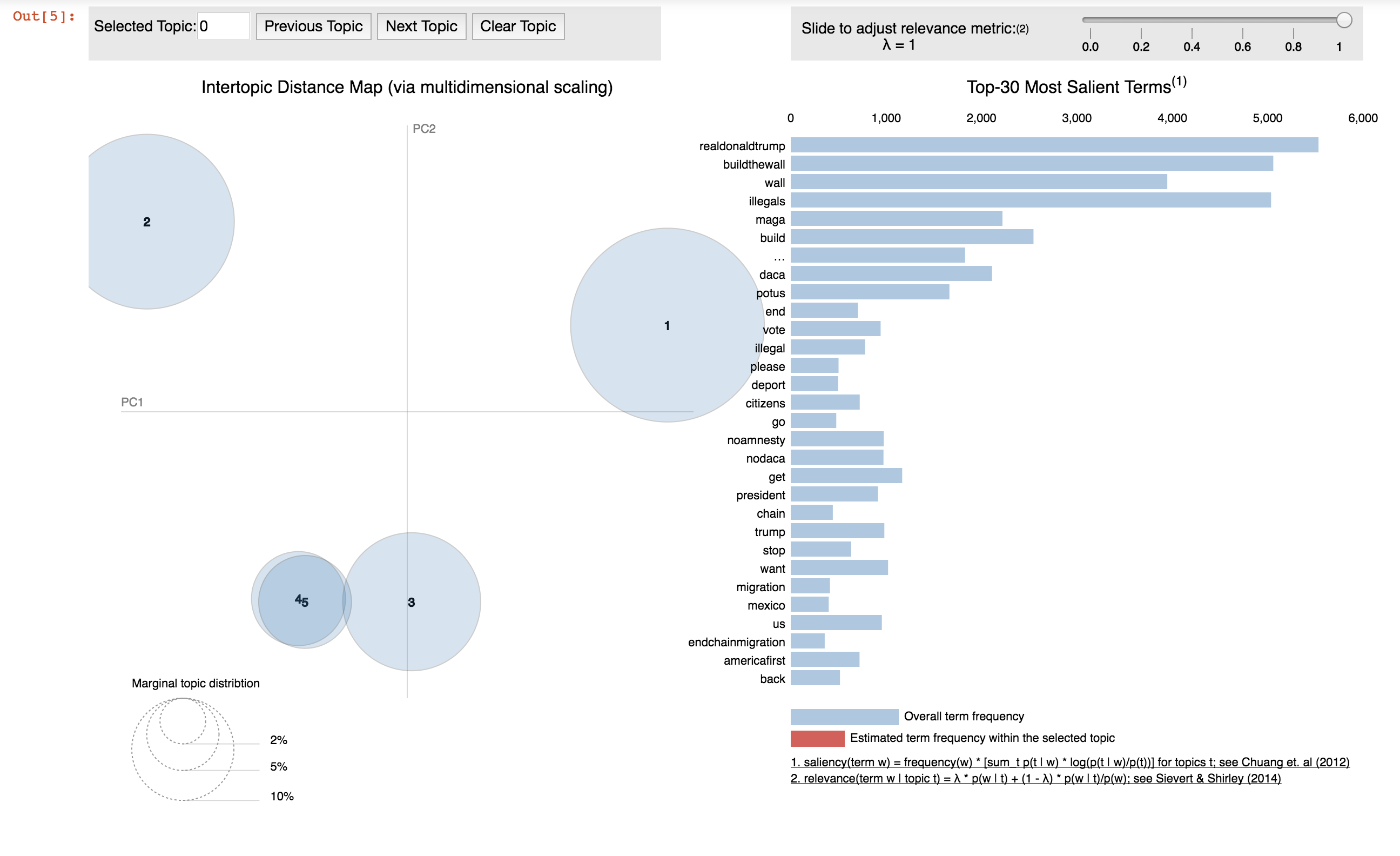
You can also add top mentioned users to each community's .top_mentions property:
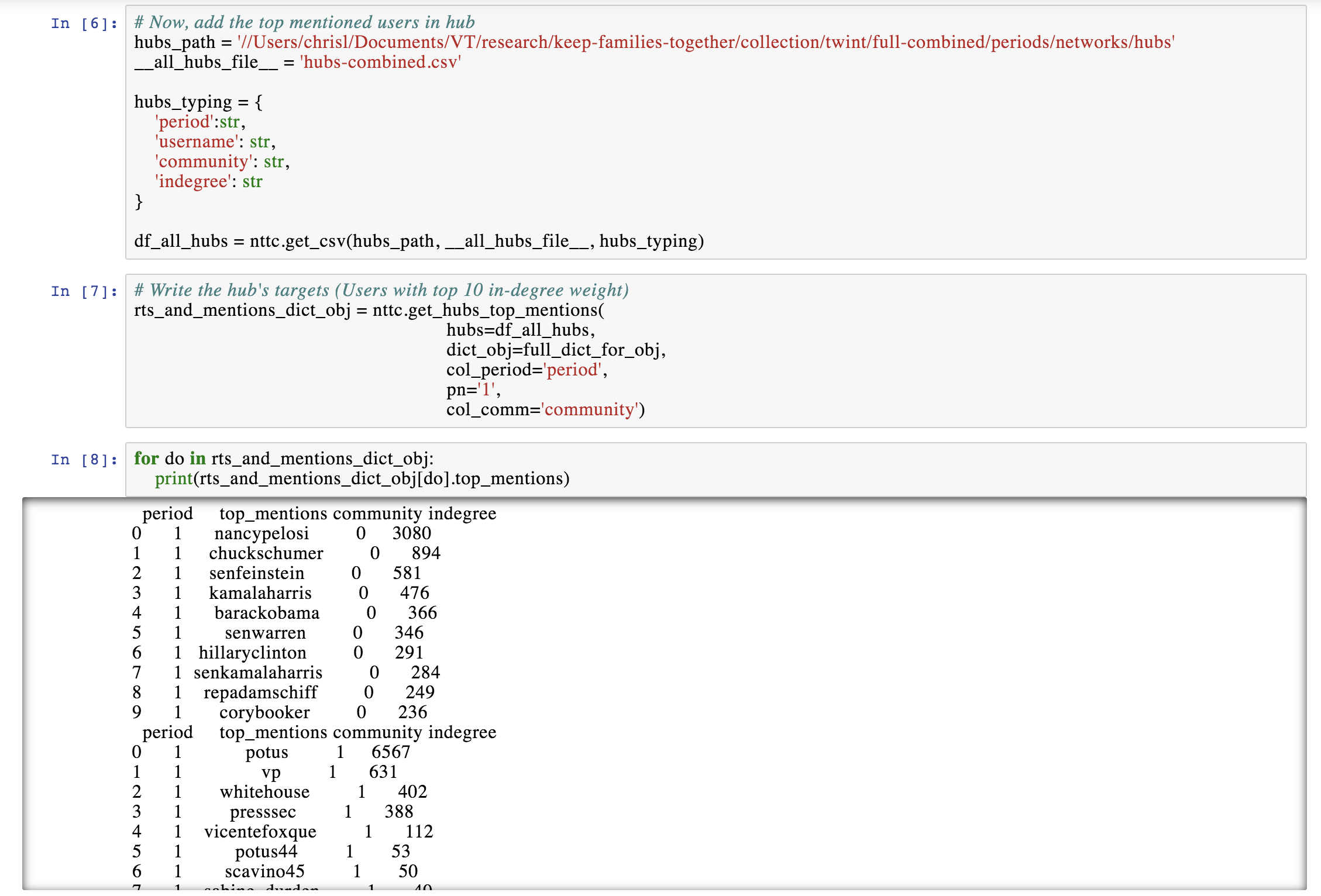
Merge top RT and mentioned users (in-degree) information to each community's .full_hub property:
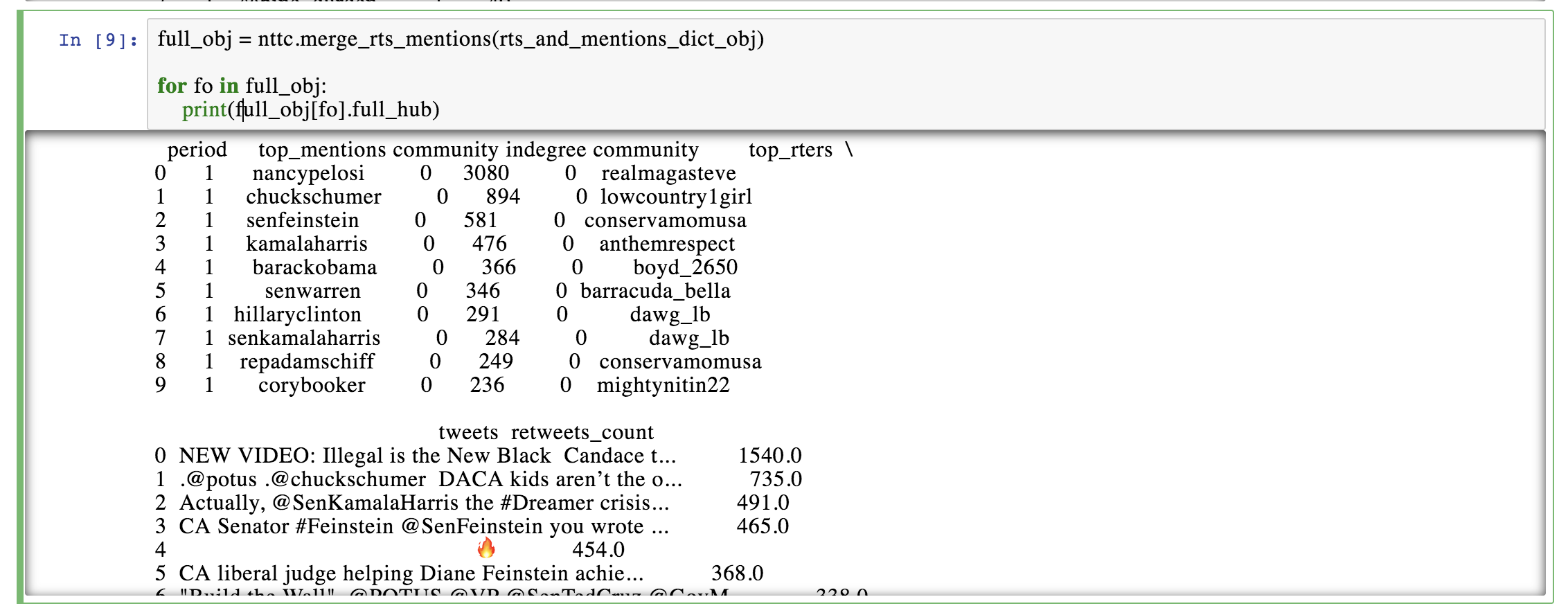
You can also output the entire hub as a CSV for closer analysis:
nttc.create_hub_csv_files(
full_obj=full_obj,
sys_path=data_path,
output_file='p1_full_hubs.csv',
drop_dup_cols=True
)
Plot community similarity indices (Jaccard's Co-efficient)
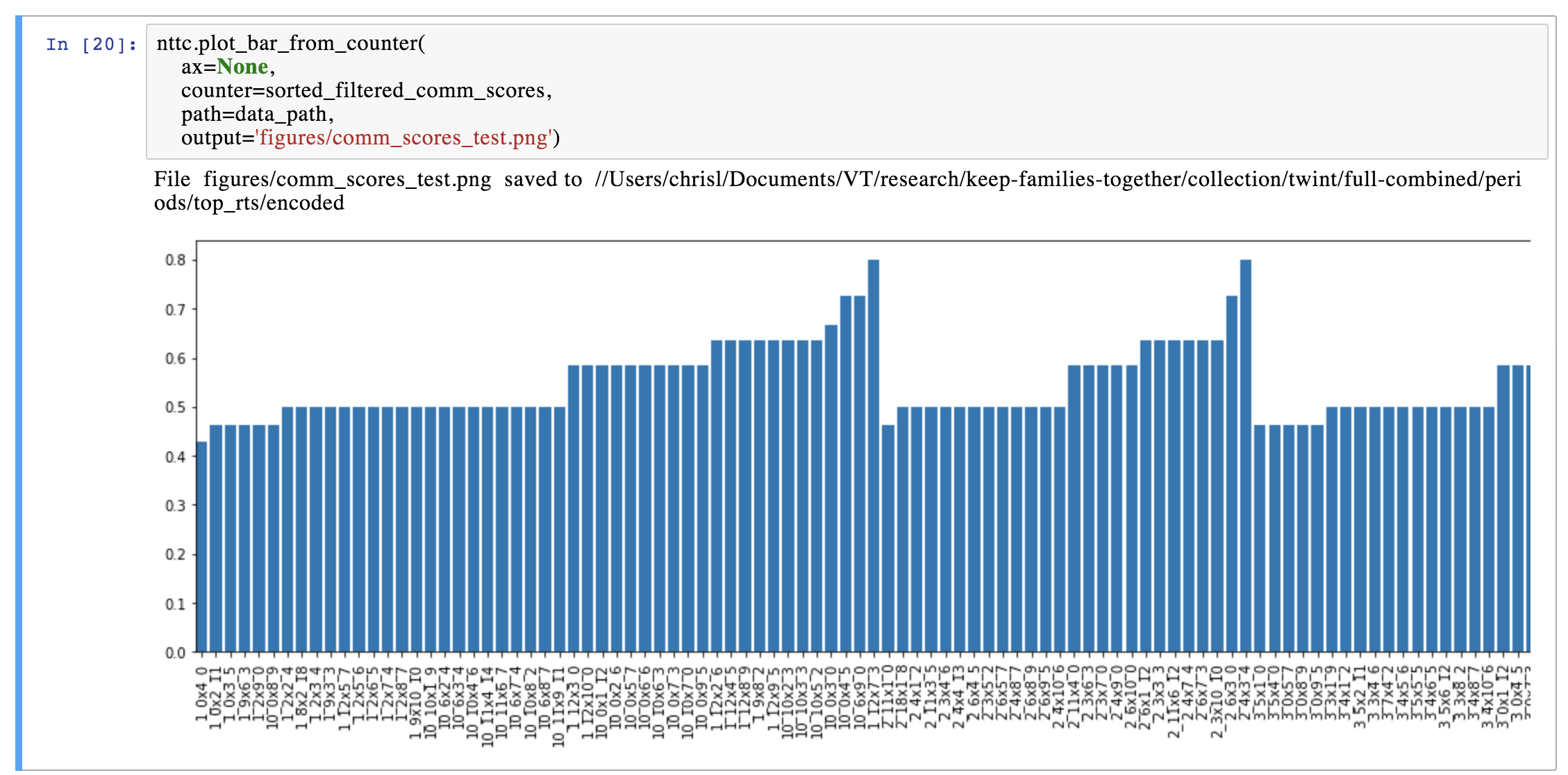
Analyze and return a list of alike communities across periods
- Init a new
matchingCommunitiesObjectand write a dict of users withmatching_dict_processor()to send tomatch_maker(). - Write a list of tuples (matched community pairs and their scores) with
match_maker()to send tocommunity_grouper(). - Analyze the intersections and unions of, in this case, the
sorted_filtered_mentions' values and output a list of sets, where each set includes alike communities across periods in the corpus.
Process and visualize alike communities across periods
- Init a new
allPeriodsObjectand merge all network node and edge data from each period into one dict withbatch_csv(). - Init new periodObj() as needed with
initializePO(), retrieve the unique comunity numbers withget_comm_nums(), and slice up each period per Community into the periodObject withcomm_sender(). Repeat per Period. - If desired, and as needed, access each periods network data for use.
- Visualize each alike community network graph with
draw_subgraphs(), a networkx helper function, as desired.
Distribution update terminal commands
# Create new distribution of code for archiving sudo python3 setup.py sdist bdist_wheel # Distribute to Python Package Index python3 -m twine upload --repository-url https://upload.pypi.org/legacy/ dist/*
Project details
Release history Release notifications | RSS feed
Download files
Download the file for your platform. If you're not sure which to choose, learn more about installing packages.


